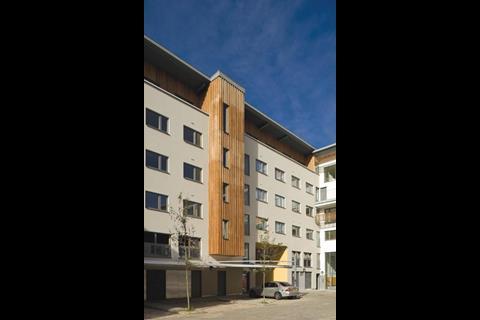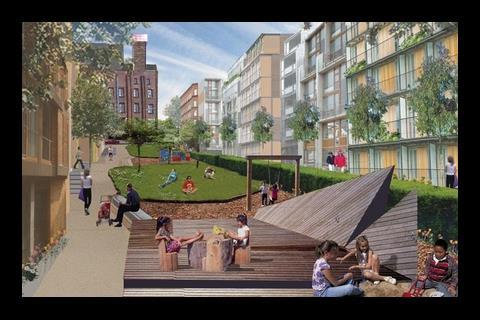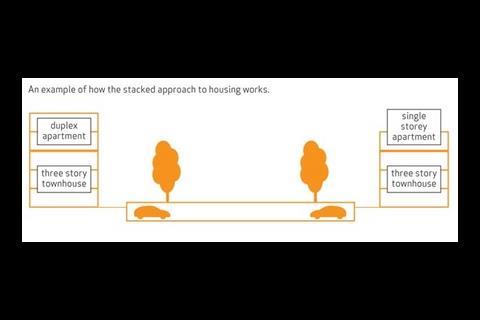Family living has come back on the agenda as the market turns its back on apartments. So architects and developers have to crack the problem of making the family house comply with urban density standards and be attractive enough for a family to want to live there. Josephine Smit looks at two solutions
Timber wharf, east London
One housing group
Project
Could the back-to-back have a place in 21st century housing? That is a question which One Housing Group’s Timber Wharf mixed-use scheme in east London explores.
The scheme of four buildings containing 87 homes and just over 2,000m2 of commercial space includes one building where a terrace of seven townhouses back onto offices, and both are topped by apartments. Although this is a thoroughly urban site, the houses are seven large family units for social rent. The site beside the Regents Canal is close to the busy Kingsland Road and a disused railway viaduct which is to be put back into use for the East London Line rail extension.
The project, which has just been completed, was developed by housing association One Housing Group to a design by architect Jestico + Whiles, with architect Chassay & Last working on one of the four buildings. Also on the project team were structural engineer Alan Conisbee & Associates, client’s representative MacConvilles and contractor John Laing Partnership.
The brief
The site’s complex mixed-use solution came partly from its designation as a defined employment area. Julian Dickens, associate with Jestico + Whiles, explains: “At that time Hackney council wanted 50% of floor area to be in employment-generating uses, although there was a lot of redundant office space in the Kingsland Road and our client naturally wanted to provide the maximum residential.” After some negotiation with the council, a compromise was reached: 25% B1 and A3 use, and 75% residential.
The housing association wanted large family houses on the site to meet housing need within the borough. The architect was however mindful of the noise that could soon be coming from trains using the viaduct. Dickens outlines E E how the idea of dividing a building vertically to create the residential/commercial back-to-back emerged from those factors: “We thought that by having the offices facing one way and the residential facing away from the viaduct we could create an acoustic buffer. Instead of creating two separate buildings, we thought it would be interesting to create a split building. The back-to-back houses of Yorkshire were an inspiration. This was taking the idea one step further into mixed use. A lot has been driven by acoustics here.”
Feedback
The terrace of three-storey four-bedroom houses have front gardens, first floor lounges and from the front look exactly as a house should. “To most people it is not apparent how the building works,” says Dickens. The differences are only evident at the back of the house, where instead of windows and doors, there are elements such as stairs and bathrooms, which do not require daylighting.
‘This brings a European dimension to Manchester. This is being done in Malmo and Dublin, but not in England’
Mick Timpson
Backing a house against an office could create tensions with building regulations, but Dickens says issues of acoustic regulations and acoustic isolation were easily resolved and that “the scheme passed acoustic testing with flying colours”.
Obviously the offices and homes have generously proportioned windows on their front elevations to maximise daylighting. But window designs for the houses did have to be carefully assessed to give the best balance of light and thermal insulation, says Dickens.
He says some lessons have emerged from the development of this unusual housing model: “If we were to re-use it, I would try to refine it. We had an issue with regulations on the entrance to the housing. We originally wanted the entrance to lead straight into the living space, but issues over means of escape meant that we had to have the entrance leading into a hall.
“My and the practice’s approach to housing is to design for the site and this specific solution came out of the site conditions. But there is no reason why we couldn’t do it again. We are interested in it as a model. It does have potential.”.
Holt Town, east Manchester
Cibitas investments
Project
Holt Town does not yet have any homes built, but already some regeneration experts are describing it as potentially one of the most influential housing projects around. Their praise stems from the scheme’s innovative approach to family housing.
The 84-acre Holt Town site, formerly known as the Bradford Road Triangle, received Manchester’s largest ever residential-led planning consent last December, with approval given to build 4,300 homes, plus school, retail and commercial space. There are plans for a Metrolink tram stop for the proposed Ashton Metrolink extension to be incorporated into the scheme.
The scheme is being driven by Cibitas Investments, urban regeneration company New East Manchester and Manchester council. Masterplanner EDAW has created the development framework, and GVA Grimley, Arup, Davis Langdon and Mace are working on property and land assembly, infrastructure, cost consultancy and programming advice respectively. Architect Studio Egret West is working with EDAW.
The brief
By locating flats over the top of the houses we could not bring light into the top of the homes. It would have been nice to have had a more generous stair with daylighting
Julian Dickens
The market for urban apartments was still buoyant when the brief for Holt Town was formulated, but its premise now appears prescient. Mick Timpson, principal in the Manchester office of EDAW, explains: “There is a glut of two-bedroom apartments around. The brief here was to find the middle ground between the two-bedroom apartment in the city centre and the suburban house outside it in places like Didsbury, so that a family could live in the homes but still be five minutes from the main shops. The proposed tram link is the clincher – it provides a fantastic opportunity to link families into the city.”
The client team describes its planned neighbourhood as an “urburb”, “combining the convenience and buzz of the city centre with the amenities and space of the suburbs”. The new neighbourhood will be environmentally friendly, with measures ranging from rainwater harvesting to bicycle stores.
Feedback
Timpson explains how the design team responded to the brief: “We needed a new residential typology. The site was so close to the city centre that we couldn’t roll out townhouses. Holt Town has a couple of residential towers, but our default solution was the perimeter block. That gives privacy on the inside of the block, and a public life on the outside.”
The block effectively forms a stacked terrace, with two- and three-bedroom duplex apartments on top of each three- and four-bedroom family houses. The solution keeps density levels high, Timpson says: “We’re reaching densities of around 198 units a hectare, which includes the towers. It is a healthy density for a sustainable community, so that it can support a school and so on.”
Because the perimeter block is only one house thick, the homes crucially have daylighting both front and back. Timpson says: “A house looks and feels like a normal house – it has plenty of daylight and privacy.”
Manchester’s own guidance on making new homes accessible to the disabled sets high space standards, so the project team has opted to make Holt Town’s homes 25% bigger than market norms. “That was quite a risk for the client, but it is attractive for the city,” says Timpson.
The only other challenge that the design solution has so far created has centred around car parking and where to put it. The answer in some locations might be to omit it altogether, but here EDAW’s solution is to use the natural advantage offered by the sloping site and put it under the perimeter block.
While Holt Town’s approach has won plaudits from the experts, it is too early to say whether the homes will be a hit with homebuyers as phase one of the scheme goes on site later this year. Nonetheless, such is the level of interest in the approach that EDAW is talking to several other clients about repeating it.
But can you get planning permission?
Both schemes featured in this What’s working found favour with the planners. Julian Dickens, associate with Jestico + Whiles, says of the response to Timber Wharf: “It was very well received. In fact, it was commended by the committee.” Mick Timpson, principal of Edaw echoes that: “Manchester is really gung-ho about this kind of stuff. Because it is new the planners wanted to double check that the densities could provide the right levels of private space and amenity space so we had to go quite a long way down the line to test and prove it.”
Others have been less lucky, and had their housing innovation stymied by planners. Ian Tant, joint senior partner with planning consultant Barton Willmore Partnership, says: “PPG3 pressed up density and the government is rightly proud it is having an effect. The froth has suddenly gone out of the market which is not necessarily bad because it has given us the chance to pause for thought on what works. The difficulty for local authorities is adjustment.”
Downloads
Source
RegenerateLive




























No comments yet